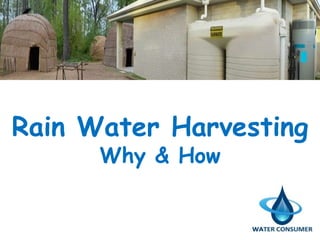Rainwater Harvesting
- 1. Rain Water Harvesting Why & How
- 2. Rainwater harvesting can be harvested from the following surfaces:
- 3. Rooftops If buildings with impervious roofs are already in place, the catchment area is effectively available free of charge and they provide a supply at the point of consumption. Paved and unpaved areas i.e., landscapes, open fields, parks, storm water drains, roads and pavements and other open areas can be effectively used to harvest the runoff. The main advantage in using ground as collecting surface is that water can be collected from a larger area. This is particularly advantageous in areas of low rainfall.
- 4. Water bodies: The potential of lakes, tanks and ponds to store rainwater is immense. The harvested rainwater can not only be used to meet water requirements of the city, it also recharges groundwater aquifers.
- 5. Storm water drains: Most of the residential colonies have proper network of storm water drains. If maintained neatly, these offer a simple and cost effective means for harvesting rainwater.
- 6. Whether to store rainwater or use it for recharge: The decision whether to store or recharge water depends on the rainfall pattern and the potential to do so, in a particular region. The sub-surface geology also plays an important role in making this decision.
- 7. For example: Delhi, Rajasthan and Gujarat where the total annual rainfall occurs during 3 or 4 months, are examples of places where groundwater recharge is usually practiced. In places like Kerala, Mizoram, Tamil Nadu and Bangalore where rain falls throughout the year barring a few dry periods, one can depend on a small sized tank for storing rainwater, since the period between two spells of rain is short. Wherever sub-strata is impermeable recharging will not be feasible. Hence, it would be ideal to opt for storage.
- 8. In places where the groundwater is saline or not of potable standards, the alternate system could be that of storing rainwater. Beyond generalizations, it is the requirement that governs the choice of water harvesting technique. For example, in Ahmadabad, which has limited number of rainy days as that of Delhi, traditional rainwater harvesting tanks, known as tankas, are used to store rainwater even today in residential areas, temples and hotels.
- 9. Know more about Water Conservation on WaterConsumer.org.









